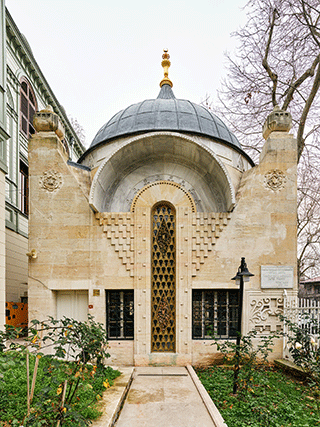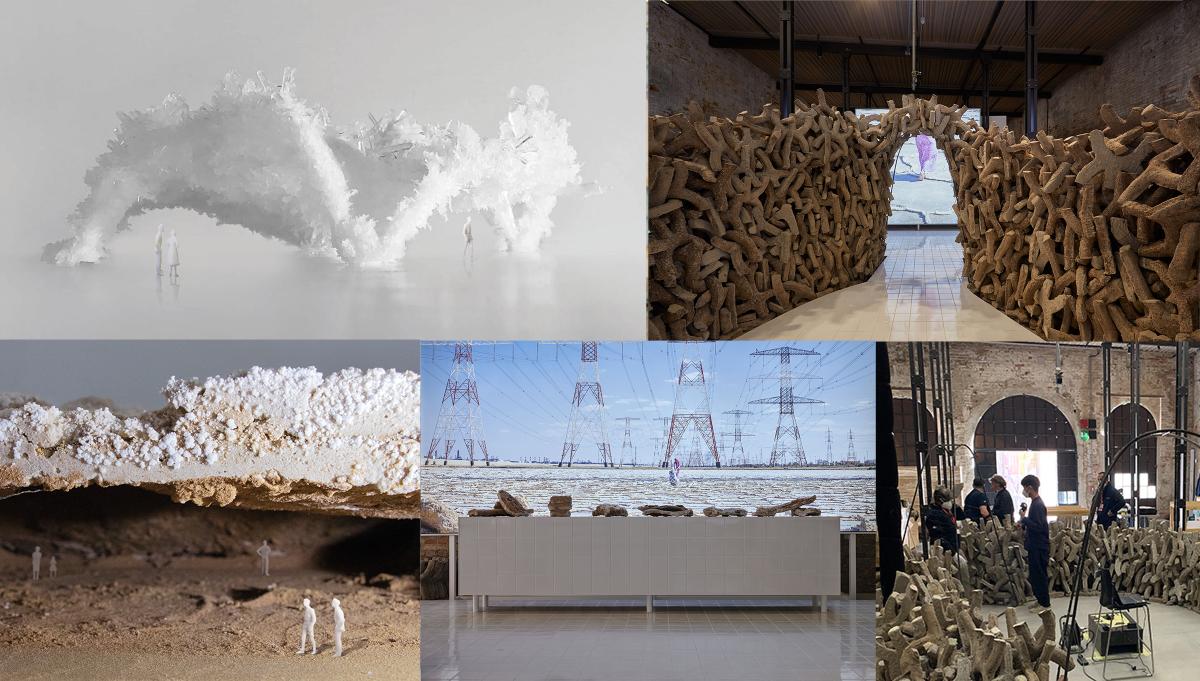Lectures, Conferences & Events» Past Lectures & Events
Wael Al Awar
Wetland: A Future Vernacular
Abstract: Can industrial waste produced by our cities lead us to a future vernacular for architecture?
Today, it is clear that we urgently need to question the way we use materials and design space. Faced with an ongoing environmental crisis, architects have a responsibility to explore local resources and seek out possibilities that can help repair the imbalances caused by decades of industrial production and unsustainable living patterns.
In response to this urgency, waiwai was drawn to the UAE’s sabkhas, salt formations in a wetland ecosystem that constitutes 5% of the country’s geography. Wetlands are nature’s laboratories, transitional spaces between land and water where biodiversity thrives. The sabkhas also contain important lessons from architectural history, with notable examples such as Siwa in western Egypt.
Industrial desalination operations in the UAE are a source of large quantities of wastewater brine, which can be used as a structural material just as sabkhas once were. Working in collaboration with a research laboratory at New York University Abu Dhabi, waiwai developed a cement compound using brine as a binding agent and partnered with the University of Tokyo to develop a method of digital fabrication. This prototype was presented as Wetland at the UAE Pavilion at the Venice Architecture Biennale and 2021, where it was recognized with the Golden Lion.
In this talk, Wael Al Awar, founding partner of waiwai, addresses the potential for industrial waste to offer solutions for designing and building that also reintroduce local culture and identity into architectural production. This extended research informs waiwai’s approach to projects in the UAE, Japan, and beyond.
Bio: Wael Al Awar is an architect and founding partner of Dubai- and Tokyo-based firm waiwai. After returning to the Middle East from Tokyo, he founded waiwai (formerly ibda design). Wael layers his interests in natural phenomena into an architecture of light, time, structure, and landscape. He seeks to create an architecture that is more than fabrication, that remains open to adaptation. His site-specific designs encourage unexpected experiences. Wael curated the UAE National Pavilion at the Venice Architecture Biennale in 2021, which was awarded the Golden Lion.
waiwai was named among the top 17 architects and top 50 influential designers of the year by Nikkei Magazine in 2019, recognized by Architectural Record's annual Design Vanguard issue as one of the top 10 emerging firms in the world in 2018 and included in Architectural Digest’s top 50 offices in the Middle East in 2017 and 2022. waiwai was a Shortlisted Nominee for the Aga Khan Architecture Award in 2019. The firm’s awards include the AD Middle East Award in 2022, Best Cultural Building; the Golden Lion at the Venice Architecture Biennale in 2021; the Arab Architect Award in 2019; the New York Design Award 2018, Silver Medal; the Hong Kong Design Award 2018, Gold Medal; the First Prize at the AIA Middle East Design Awards in 2018; the London Design Award 2016, Silver Medal; and the SD Review Award, Tokyo, 2015, Shortlisted Nominee.
SOCIAL HANDLES
Wael instagram:
@wael.al.awar
https://www.instagram.com/wael.al.awar/
waiwai instagram:
@waiwaidesign
https://www.instagram.com/waiwaidesign/
waiwai website:
https://waiwaidesign.com/
Image: Clockwise: (1) Crystallization experiments at waiwai office. Image courtesy National Pavilion UAE – La Biennale di Venezia and waiwai (2) Image courtesy National Pavilion UAE La Biennale di Venezia. Photography by Frederico Torra for PLANE-SITE. 0235 1(3) Image courtesy of waiwai (4) Image courtesy National Pavilion UAE La Biennale di Venezia. Photography by Frederico Torra for PLANE-SITE. _DSF5060 (5) Material research at the Wetland lab at Alserkal Avenue. Image courtesy National Pavilion UAE – La Biennale di Venezia and waiwai.
Samia Henni
Against the Regime of Emptiness
Abstract: The territories of both hot and cold deserts embody various forms of anthropogenic exploitation, such as colonial dispossession, resource extraction, and civil and military occupation. And yet, among the most common platitudes about the desert are ideas that “deserts are empty,” that “the desert is absent of life,” or that “there is nothing at all in the desert.” This misleading conceptualization of the desert has served to legitimize its transformation, manipulation, toxification, and destruction. This stereotype was, for instance, the justification offered by the French army to defend its choice to use the Algerian Sahara—then a French colonized territory—as the firing field for France’s first atomic bombs between 1960 and 1966. According to General Charles Ailleret, the head of France’s nuclear program, the Sahara was “a land of thirst and fear, from which all life was reputedly absent,” the designated desert characterized by “the total absence of animal and vegetal lives.” Contrary to this colonial invention, this lecture aims at tracing and naming the spatial, atmospheric, and geological impacts of France’s atomic bombs in the Sahara. It demonstrates how the imposed “regime of emptiness” enabled the French authorities to “fill” the Algerian desert with radioactive architecture and wastes.
Bio: Samia Henni is a historian and an exhibition maker of the built, destroyed, and imagined environments. She is the author of the multi-award-winning Architecture of Counterrevolution: The French Army in Northern Algeria (gta Verlag, 2017, EN; Editions B42, 2019, FR), the editor of War Zones, gta papers no. 2 (gta Verlag, 2018), and Deserts Are Not Empty (Columbia Books on Architecture and the City, 2022). She is the maker of the exhibitions Archives: Secret-Défense (ifa Gallery, SAVVY Contemporary, Berlin, 2021), Housing Pharmacology / Right to Housing (Manifesta 13, Marseille, 2020) and Discreet Violence: Architecture and the French War in Algeria (Zurich, Rotterdam, Berlin, Johannesburg, Paris, Prague, Ithaca, Philadelphia, Charlottesville, 2017–21). She teaches history of architecture and urban development at Cornell University's College of Architecture, Art and Planning. Currently, she is working on a commissioned exhibition project, titled Performing Colonial Toxicity (2023), with If I Can't Dance I Dont't Want to be Part of Your Revolution and Framer Framed in Amsterdam; and a book projec, titled Colonial Toxicity: French Nuclear Architecture and Wastes in the Sahara (2024), which investigates France’s nuclear weapons program and its aftermath in the Algerian Sahara.
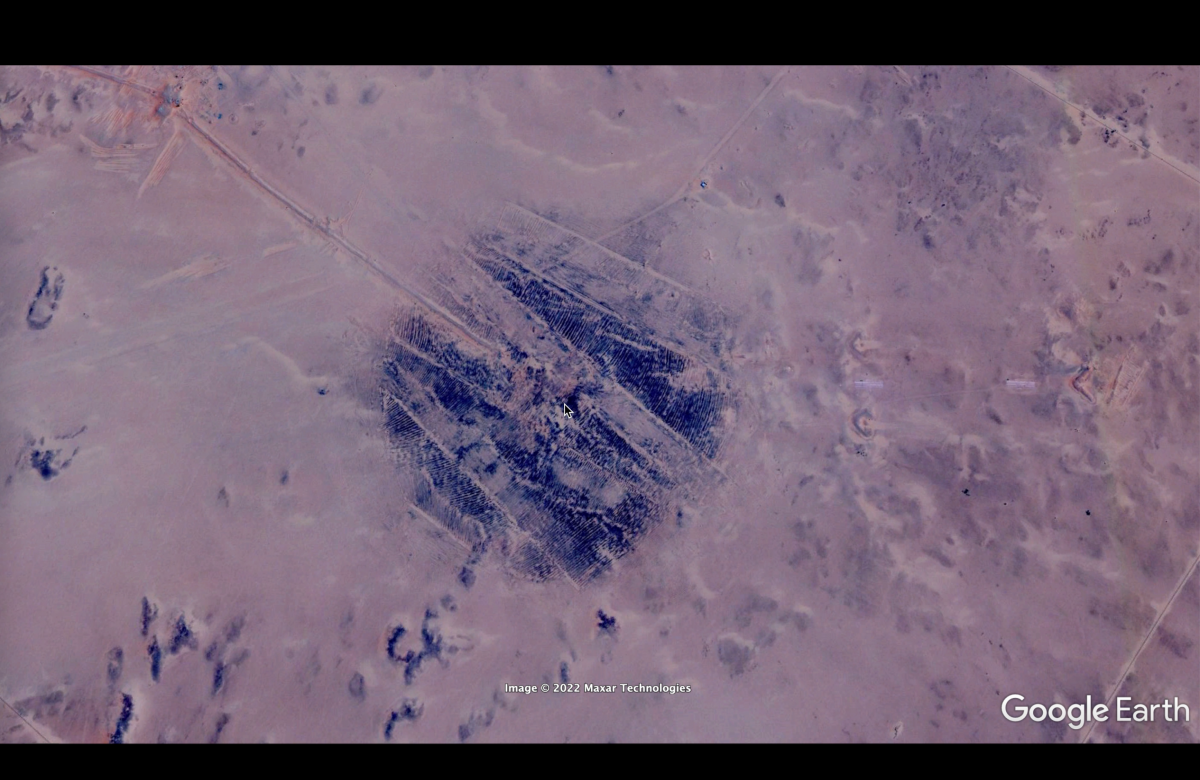
Image left: The trace of the explosion of France’s first nuclear bomb in the ground zero, the Algerian Sahara © 1960, Raymond Varoqui / SCA / ECPAD. Image right: The trace of the explosion of France’s first nuclear bomb in the ground zero, the Algerian Sahara © 2022 Maxar Technologies.
Semra Horuz
Ottoman Tour d’Europe: Architecture, Urbanism, and Late Ottoman Travelogues
Abstract: This talk explores the architectural history of nineteenth-century Ottoman travelogues on western Europe. There are more than twenty personal travel accounts that were published by Ottoman intellectuals in Istanbul between 1850-1910. Ottoman intellectuals’ impetus to set off a journey through Europe, their response to specific urban and architectural elements embodies substantial transformations of the nineteenth-century Ottoman society. Notable among these are the emergence of middle-class urbanites, the growing curiosity about the empirical data and material know-how of urban modernization, a demand for historical consciousness and reification of authentic local cultural values via the built environment, and new modes of leisure culture. This talk centers on travelers’ perception of architecture and urbanism within a self-reflective perspective and displays how late Ottoman travel boom reflected and became a performative aspect of the nineteenth-century Ottoman modernization.
Bio: Semra Horuz is a historian of architecture and urbanism specializing in late Ottoman visual and material cultures. Her studies focus on the nineteenth-century Ottoman modernization and the transformation of Istanbul. She has also sustained interest in cultural mobilities and digital humanities. Horuz received her MA in Architectural History from the Middle East Technical University, Ankara and obtained her Ph.D. from the Technical University of Vienna, Austria. Before joining in AKPIA@MIT, she was a visiting PhD student in University of Oxford, and worked at Bilgi and Bahçeşehir University, both in Istanbul. She now works on her book manuscript-in-progress titled, Ottoman Tour d’Europe: Architecture, Urbanism, and Late Ottoman Travelogues.
Image Credit: A collage of pages from İngiltere Memalikiyle Londra Şehrine Seyahat (n.d.) by an anonymous author, Avrupa’da Ne Gördüm(1891) by Ahmet Ihsan, Avrupa Hatıratım (1895) by Mehmet Enisi, and Avrupa Seyahatnamesi (1898) by Mustafa Sait.
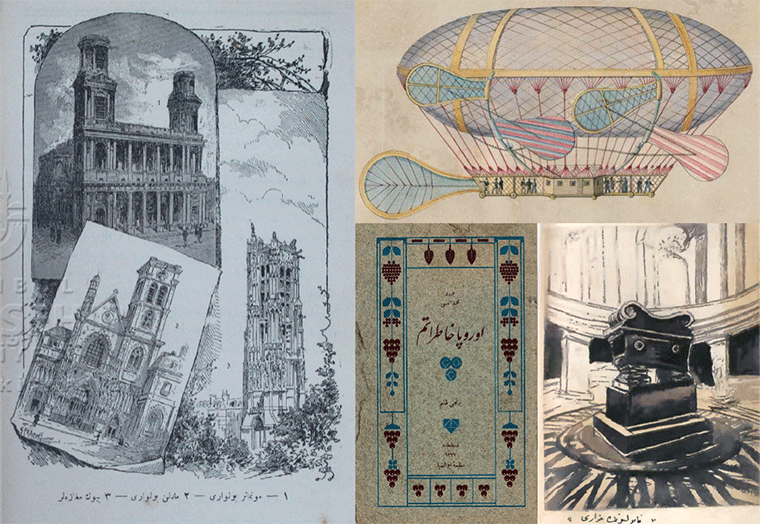
Vivien Sansour
Something Else is Possible
Abstract: Often times when Palestinian farmers put seed in the ground, they mutter a quiet prayer, “may we eat and may we feed others”. This and many other linguistically profound sayings provide a lens into a cultural design that had been well based in the idea that our survival as individuals is connected to the well being and survival of our community. In this lecture, Vivien Sansour, takes us through a journey of people, and seeds that weaves stories that help us navigate a world that is in a state of hospice. How imagination and science made it possible for humans to develop bread from a wild grass, and how this relationship of co-creation between humans and other beings can inform our future, are urgent contemplations. From the death of species to the movements of people, Vivien invites us to engage in new modes of design that are based on the kinship of plants and the inspirations drawn from old stories in order to be what she calls “better designers”. In this lecture Vivien will share images and processes of development for two of her most recent art works, “The Belly is a Garden” which was commissioned by the Fisher Center for Performance Arts in New York Bard College, and “Something Else is Possible” an art book and installation exhibited as part of the Fotoindustria Biennale in Bologna, Italy 2021.
Bio: Vivien Sansour is an artist, researcher, and writer. She uses installations, images, sketches, film, soil, seeds, and plants to enliven old cultural tales in contemporary presentations and to advocate for seed conservation and the protection of agrobiodiversity as a cultural/political act. Vivien founded the Palestine Heirloom Seed Library in 2014 where she worked with farmers in Palestine and around the world. As an extension of this project she created The Traveling Kitchen, a social engagement project aimed at bringing to the forefront conversations about climate crisis, food politics, and the imagining of new worlds. Her work as an artist and been showcased internationally, in places such as The Chicago Architecture Biennale, Victoria and Albert Museum, Dutch Design Week, Berlinale, Istanbul Biennale, Fotoindustria, and the Venice Art Biennale. As a writer, Vivien has written for magazines such as E-fluxx, Mold Magazine, and The Forward where she was featured as a food columnist.
An enthusiastic cook, Vivien works to bring threatened varieties “back to the dinner table to become part of our living culture rather than a relic of the past.” This work has led her to collaborate with award-winning chefs, including Anthony Bourdain and Sammi Tamimi.
A former Harvard University Fellow, Vivien is currently the Distinguished Artistic Fellow at Bard College where she premiered her art performance, “The Belly is A Garden” at the Fisher Center for Performing Arts and the Bard farm. As part of her fellowship Vivien is teaching in the Experimental Humanities department where she is developing a course on human and nature design in the Hudson Valley entitled, “The Belly is A Garden”- El Batin Bustan 2022-2023.
Images: Left: Image of the sketch is from my work at the Fotoindustria Biennale in Italy, 2021 (Vivien Sansour) Right: Sansour in her garden in Palestine taken by Samar Hazboun.
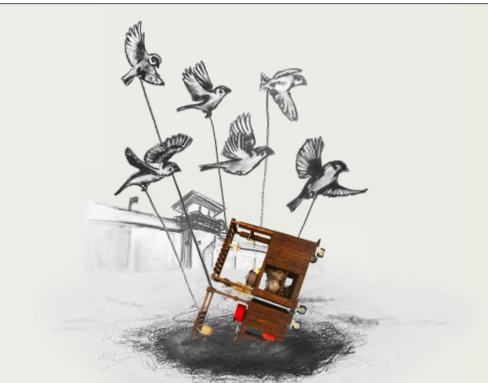
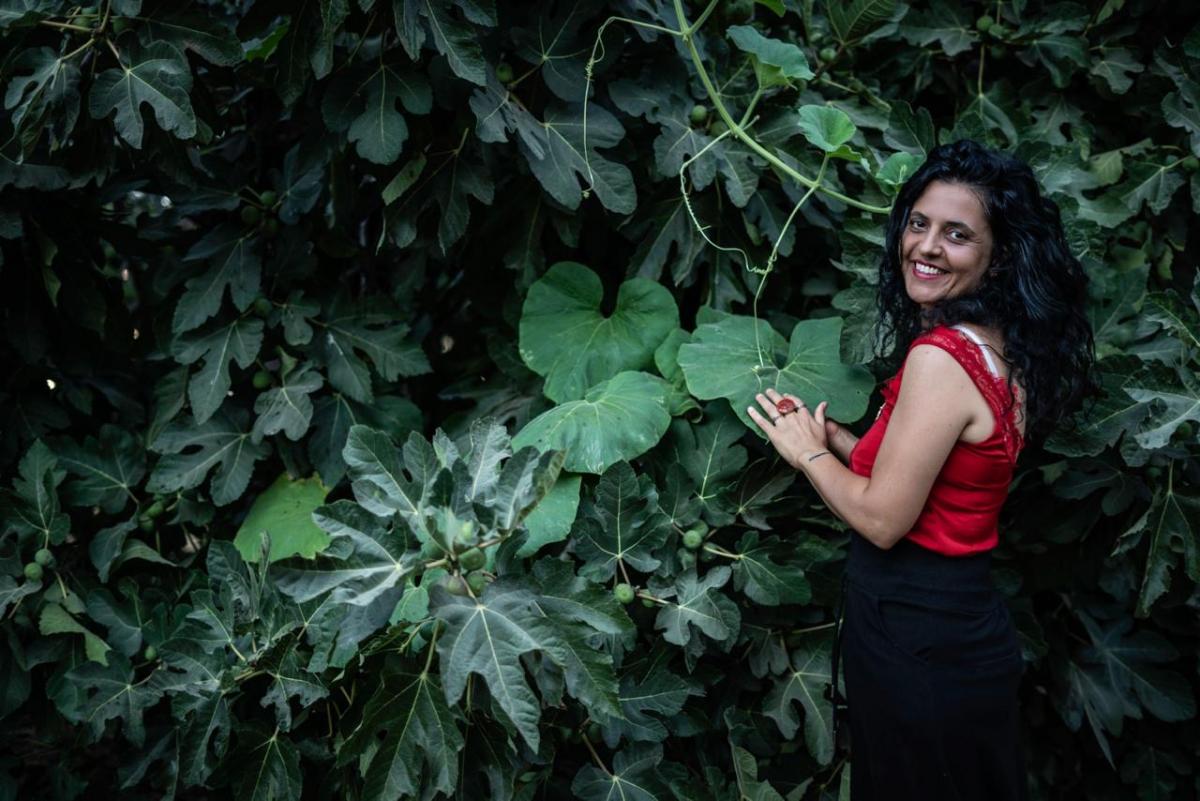
Sharon Smith
The Sultan's Architect Called Home: Raimondo D'Aronco Between Turkey and Italy
Abstract: Raimondo Tommaso D'Aronco (1857–1932), an Italian architect from Gemona del Fruli, served as the chief palace architect to the Ottoman Sultan Abdülhamid II in Istanbul for sixteen years. He became so after the Sultan requested the Italian government send an architect to design an exhibition marking the Sultan’s twenty years of rule. An earthquake in 1894 put an end to the project, but D’Aronco stayed in Turkey as the first ever foreign-born palace architect.
Raimondo D’Aronco trained in an Arts and Crafts school in Northern Italy, near his home of Gemona del Furli, beforeleaving for Venice to study ornamental design at the Academy of Fine Arts. As a master builder, D’Aronco became astrong voice for modernism and the Art Nouveau style, or Stile Floreale in Italian. In Istanbul, where he worked aside such noted architects as Sarkis Balyan, D’Aronco’s style soon became a hybrid of traditional Ottoman architectural vocabulary with Art Nouveau motifs. The merging of these styles and sensibilities resulted in a distinctive and modern design.
The significance of the international, elegant, and modern designs of Raimondo D’Aronco were not unnoticed in his home of Italy. In 1901, D’Aronco was awarded the position as primary architect of The First International Exposition of Modern Decorative Arts through a juried competition, to be held in Torino in 1902. His designs reflected his diverse and international background. At the time he won the competition he was still working in Turkey as architect to the Sultan. Many of his structures reflected the architectural language he acquired in Istanbul, including the Central Rotunda for the exposition in which the domes echoed that of Hagia Sophia. For his audience, the exotic and oriental motifs added to the mystic of D’Aronco, his patron, Sultan Abdülhamid II, and faraway lands, increasing the international theme of the exhibition and intensifying the debate for a newly unified Italy’s search for a modern national style.
Bio: Currently holding a faculty post at Boston College, Sharon C. Smith is an educator, scholar, artist, and curator. Previously, she has served as an associate academic and Curator for the Middle East and Africa at Arizona State University (ASU). Smith engaged in projects at ASU with the Institute for Humanities Research, the Center for Religion and Conflict, and the School of Historical, Philosophical, and Religious Studies. She has served on numerous committeesand boards including as a Participating Expert for UNESCO’s Safeguarding of Syria’s Cultural Heritage Committee. Most recently, she served as Chair of the Endangered Libraries and Archives Committee for the Middle East LibrariansAssociation (MELA) and was named one of ten experts to the Center for Research Library’s International Collectionsand Content Group. At ASU, Dr. Smith was affiliated with the Council for Arabic and Islamic Studies and an officer in the Center for Maghrib Studies.
Prior to her work at ASU, she served as the founding Program Head for the Aga Khan Documentation Center at MIT (AKDC@MIT), a research center holding select archives of architects and scholars working in/on the Middle East. Under her tenure, AKDC@MIT won the prestigious Mohamed Makiya Prize: Tamayouz Excellence Award (Aga Khan Documentation Center, 2015-2017)). At AKDC@MIT, Smith also served as Co-Director and P.I. of Archnet, a globallyaccessible, intellectual resource, and research portal with focus on the built environment and the material and visualculture of Muslim societies writ large as well as P.I. for LayerCake, a three-axis mapping tool allowing users to map time, narrative, and space simultaneously.
Dr. Smith earned her Ph.D. from the Graduate Program in the History and Theory of Art and Architecture at Binghamton University focusing on Early Modern Italy and the Middle East. Smith has lectured and published widely on issues of documentation, digitization, and the dissemination of knowledge, as well as on art historical topics primarily focused on visual and material culture in the Early Modern Mediterranean. Her most recent publications include “Documenting Islamic Architecture: Objectives and Outcomes in a Time of War”, International Journal of Islamic Architecture, (1 January 2021), and republished in ‘Islamic Architecture’ Today: Critical Reflections on a Vast and Growing Field, edited by Daniel E. Coslett and Mohammad Gharipour, 2022; and “Of architecture, icons, and meaning: Encountering the pre- modern city”, Proceedings of CIHA (Comité International d’Histoire de l’Art), 35th Congress, Motion: Transformation (Bologna, Italy: Bononia University Press, 2021). In addition, she is guest editor for the Journal of Material Cultures in the Muslim World: Faith in Water, Water in Faith (Leiden: Brill, 2022), and co-organized a virtual roundtable with theAga Khan University, London, entitled Interrupted and restricted: Digital Humanities and Ethics in a Time of Crisis.

